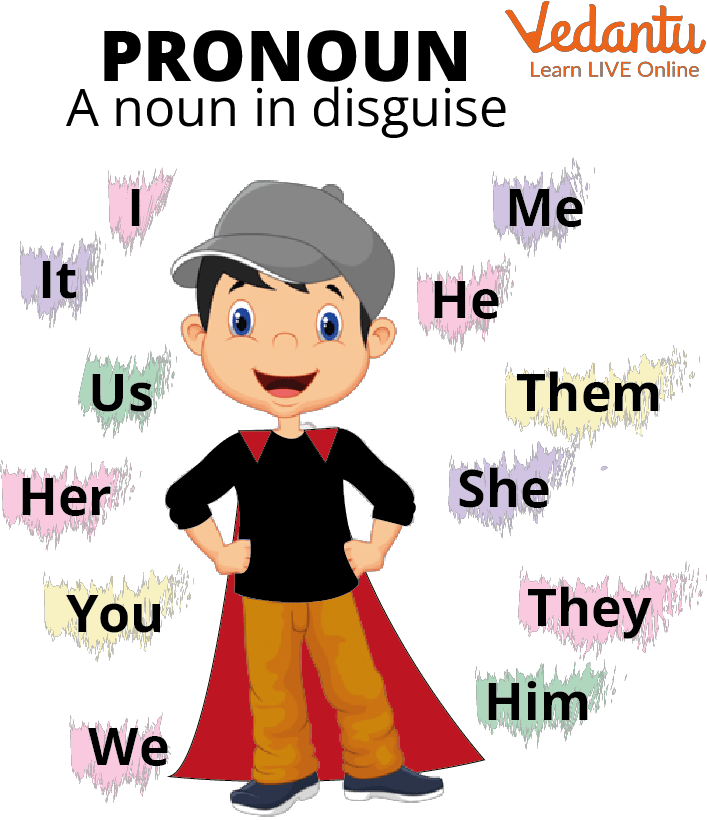




Learn and Solve Essential Grammar Exercises for Class 2 Students
English grammar is one of the most important things to learning a language. It is a set of rules for making the words and arranging them with the correct meaning. It is the second language for students in school. It is the study of words, and how they are used and work in a sentence. When we speak we use this English grammar. It helps to complete sentences in a proper way. It is a language rule that we use to create phases, nouns, and sentences. In this, we will study nouns, pronouns, adjectives, verbs, conjunctions, articles, tenses, and use of the words like A, An, and The.
Class 2 English Grammar
Noun:- A noun is a person's, place's, animal's, or thing's name.
Persons like ram, sita.
Places like houses, schools.
Animals like birds, cat.
Things like tables, chairs
For example:-
The sun rises in the east.
She cannot play the guitar.
He has no faith in God.

Noun
Verbs:- Verbs are words that show actions like sing, drink, jump, play, smile, sleep, dance, swim, laugh, cry, run, sit, and write.
For example:-
I ate my lunch.
I have eaten a little.
Let's go for a morning walk.
Adjectives:- Adjectives describing words like the number, colour, size, shape, feeling, and New/old.
For example:-
I have two books.
The butterfly is yellow.
My school is big.
Adverb:- An Adverb is a word that tells something more about verbs like daily, quickly, on, inside, under, above, here, early, late, happily, loudly, today, tomorrow, slow, and fast.
For example:-
She dances gracefully.
I ate my dinner quickly.
He saw many birds outside.
Pronouns:- A pronoun is a word that we use in place of a noun.
Common pronouns are:-
I - my, me, mine
We - our, ourselves, us
He - his, him
She - her, herself
You - your, yours
They - their, them, themselves.
For example:-
You are my best friend.
Mom said I could go.
She is very cute.

Pronouns
Conjunction:- A conjunction is a word that joins two nouns and sentences like and, or, nor, but, for, yet, so, because, before, after.
For example:-
Aarti likes singing and dancing.
I like Ras malai but my brother does not.
We like to play because it gives us joy.
Preposition:- A preposition is a word or group of words used before a noun or pronoun to show direction, place, time, a location like it, on, at.
For example:-
I live in London.
Where are you from?
Are you going to the party?
Tenses:- In Class 2 only simple past tense, simple present tense and Simple future sentence is studied.
Simple Past Tense:- It is used to talk about an action in a time before or now.
For example:- I watched.
Simple Present Tense:- It is used to tell about things in the present like every day, every week, or every month.
For example:- I like ice cream.
Simple Future Tense:- It is used to refer to actions or states that start and end in the future.
For example:- You will come.
Grammar Worksheet for Class 2
Q 1. Underline the Noun in the given sentences:-
1. Kitty is my pet cat.
2. Do you live in America?
Ans:
1. Kitty is my pet cat.
2. Do you live in America?
Q 2. Underline the verb in the given sentences:-
1. Sona sings a song.
2. Megha reads a book.
Ans:
1. Sona sings a song.
2. Megha reads a book.
Q 3. Underline the adjective in the given sentences:-
1. This is a red colour.
2. This is a big house.
Ans:
1. This is a red colour.
2. This is a big house.
Q 4. Underline the Adverb in the given sentences:-
1. Tortoise walks very slowly.
2. She never tells a lie.
Ans:
1. Tortoise walks very slowly.
2. She never tells a lie.
Summary
In this article, we discussed basic English grammar for class 2. Various topics of grammar such as nouns, pronouns, adjectives, conjunctions, etc. were used to explain the topic. English grammar worksheets for class 2 are also shared to get conceptual clarity.
FAQs on Grammar For Class 2 English
1. What are the main topics covered in the CBSE Class 2 English Grammar syllabus for the year 2025-26?
For the 2025-26 session, the CBSE Class 2 English Grammar syllabus focuses on building a strong foundation. Key topics include:
- Nouns (Naming Words)
- Pronouns (Replacing Nouns)
- Verbs (Action Words)
- Adjectives (Describing Words)
- Articles (a, an, the)
- Conjunctions (Joining Words)
- Punctuation (Capital Letters, Full Stops)
- Simple Sentence Structure
2. What is a noun? Can you give some examples of nouns we see every day?
A noun is a word that names a person, place, animal, or thing. They are also called naming words. Everything around us has a name, and that name is a noun. For example:
- Person: boy, teacher, mother
- Place: school, park, home
- Animal: dog, cat, lion
- Thing: book, table, pencil
3. What is the difference between a common noun and a proper noun?
A common noun is a general name for a person, place, or thing, like 'city' or 'dog'. A proper noun is the special name for a particular person, place, or thing, and it always starts with a capital letter. For example, 'city' is a common noun, but Delhi is a proper noun. 'Dog' is a common noun, but Bruno is a proper noun.
4. What are verbs, and why are they often called 'action words'?
Verbs are words that show an action or a state of being. They are called 'action words' because they tell us what the noun (person, animal, or thing) is doing. For instance, in the sentence "The bird sings," the word sings is the verb because it describes the bird's action. Other examples include run, eat, play, and sleep.
5. How do adjectives make our sentences more interesting? Please provide an example.
Adjectives make sentences more interesting by adding details and descriptions. They are 'describing words' that tell us more about a noun, like its colour, size, or quality. Instead of saying "I saw a dog," you could say "I saw a big, brown dog." The adjectives 'big' and 'brown' create a clearer and more vivid picture in the reader's mind.
6. When should we use the articles 'a' and 'an' before a word?
We use the articles 'a' and 'an' before singular nouns. The rule is based on the sound of the first letter of the next word.
- Use 'an' before words that start with a vowel sound (a, e, i, o, u). For example, an apple, an elephant.
- Use 'a' before words that start with a consonant sound (all other letters). For example, a book, a cat.
7. What is the purpose of using a capital letter and a full stop in a sentence?
Using capital letters and full stops is very important for making sentences clear and easy to read. A capital letter shows the beginning of a new sentence and is also used for proper nouns. A full stop (.) is a punctuation mark that signals the end of a sentence. This tells the reader to take a small pause before the next idea begins.
8. How do all the grammar parts, like nouns and verbs, work together to form a sentence?
Think of grammar parts as building blocks. To make a complete sentence, you need at least a noun (the who or what) and a verb (the action). For example, in "Birds fly," 'Birds' is the noun and 'fly' is the verb. We can add more parts like adjectives to describe the noun ("Big birds fly") to make the sentence more detailed. Every part has a job, and they work together to share a complete thought.
9. Why is it important for a Class 2 student to learn grammar basics correctly?
Learning grammar basics correctly is crucial because it helps you communicate your ideas clearly. When you know where to put nouns, verbs, and punctuation, you can form proper sentences that others can easily understand. This builds a strong foundation for writing stories, answering questions, and reading better as you move to higher classes. It is the rulebook for speaking and writing English correctly.
10. What is a common mistake to avoid when using pronouns like 'he' and 'she'?
A common mistake is using the wrong pronoun for a noun. Remember, a pronoun replaces a noun, so it must match. Use 'he' for a boy or a man (e.g., Ram is tall. He is tall). Use 'she' for a girl or a woman (e.g., Sita is singing. She is singing). Always double-check that the pronoun correctly refers to the person you are talking about to avoid confusion.















